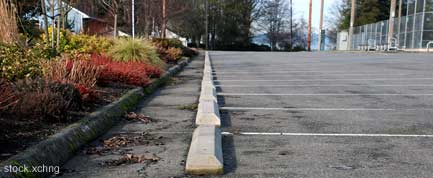Parking Lots Outnumber People, Add to Pollution

Sprawling suburban parking spaces outnumber drivers by three to one in a Midwestern county, a finding that typifies a troubling trend nationwide that increases urban heating and pollution, researchers say.
Digitalized aerial surveys taken in 2005 were used to calculate the total area devoted to parking lots in Indiana's Tippecanoe County and revealed the paved lots covered an area larger than 1,000 football fields and that there were three times as many parking spaces as drivers who lived in the county, said study leader Bryan Pijanowski of Purdue University.
Pijanowski said that his study was relevant across the country because generally Americans are paving an increasing amount of land each year on which to park when they go to the store, work, school or other places.
The results of the Tippecanoe study—355,000 parking spaces in a county that is home to 155,000 residents—are cause for concern because parking lots are a major source of water pollution, contributing 1,000 pounds of heavy metals into water runoff every year, he said.
"The problem with parking lots is that they accumulate a lot of pollutants—oil, grease, heavy metals and sediment—that cannot be absorbed by the impervious surface," said study member Bernard Engel. "Rain then flushes these contaminants into rivers and lakes."
The research findings were presented at a recent conference of land-use experts in the Netherlands.
Because parking lots also prevent the rain from soaking into the ground, they can worsen local flooding and erosion, Pijanowski said.
Sign up for the Live Science daily newsletter now
Get the world’s most fascinating discoveries delivered straight to your inbox.
The paved surfaces also add to the urban heat island effect, which can raise temperatures by 2 to 3 degrees Celsius by absorbing more of the sun's rays than the surrounding ground, said Indiana state climatologist Dev Niyogi, a colleague of Pijanowski at Purdue who did not work directly on this study.
The parking lot count focused on lots at businesses, Purdue University and other public properties. Lots on private property and multi-level parking garages were not counted, so Pijanowski says his parking space calculation is a significant underestimate.
To back away from the American trend of "paving paradise to put up a parking lot," to paraphrase songwriter Joni Mitchell, mega-churches and businesses such as "big box" retailers could build shared lots, Pijanowski suggests, which would help conserve land and stave off some of the parking lots' negative effects.
- What's Your Environmental Footprint?
- Road Trip: America's Most Paved Places
- Top 10 Ways to Destroy Earth

Andrea Thompson is an associate editor at Scientific American, where she covers sustainability, energy and the environment. Prior to that, she was a senior writer covering climate science at Climate Central and a reporter and editor at Live Science, where she primarily covered Earth science and the environment. She holds a graduate degree in science health and environmental reporting from New York University, as well as a bachelor of science and and masters of science in atmospheric chemistry from the Georgia Institute of Technology.









